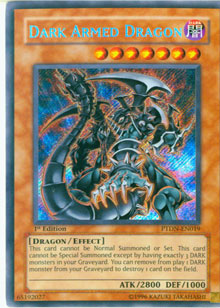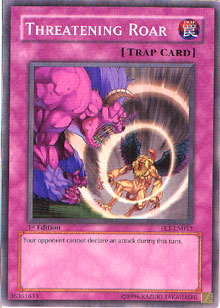The 50th Shonen Jump Championship has ended, and Dark Armed Dragon Return has taken the game by storm. While this trend began with the Advanced format, I doubt it’ll be exclusive to it. So I’ll be revisiting an archetype in order to begin considering how to defeat one of the fastest, most consistent decks in the game. It seems as if, with the introduction of this strategy, nothing is faster or more consistently powerful, so it has to be attacked from an unconventional angle. Either you find a way to win faster with more consistency (some form of OTK deck), or with something that attacks the few weaknesses the deck has.
 I don’t believe there is an OTK deck fast enough to beat Dark Armed Dragon decks, but I will be revisiting some later, using several newly presented tools. In this article, I’ll be considering how to attack the deck specifically, while still performing well against other decks. This means finding a deck that, while well rounded, has a strong advantage over the Dark Armed Dragon theme. I suggest considering this logical train of thought when choosing what to bring to a major event. As always, this article is less about the deck I’ll be sharing and more about the manner in which I arrive at it. You are, after all, reading a Traditional format column. You can’t bring this deck to major tournaments, so just follow the patterns of logic and consider incorporating them. If you want to try this deck at a local tournament or with your friends, by all means get the experience of handling it. The Traditional format is an exciting educational tool, taking all concepts and theories of the game to the extreme and teaching us how to become better Advanced format players. Let’s take advantage of it today.
I don’t believe there is an OTK deck fast enough to beat Dark Armed Dragon decks, but I will be revisiting some later, using several newly presented tools. In this article, I’ll be considering how to attack the deck specifically, while still performing well against other decks. This means finding a deck that, while well rounded, has a strong advantage over the Dark Armed Dragon theme. I suggest considering this logical train of thought when choosing what to bring to a major event. As always, this article is less about the deck I’ll be sharing and more about the manner in which I arrive at it. You are, after all, reading a Traditional format column. You can’t bring this deck to major tournaments, so just follow the patterns of logic and consider incorporating them. If you want to try this deck at a local tournament or with your friends, by all means get the experience of handling it. The Traditional format is an exciting educational tool, taking all concepts and theories of the game to the extreme and teaching us how to become better Advanced format players. Let’s take advantage of it today.
Let’s begin by assessing the average Dark Armed Dragon deck and pulling it apart. First, I’ll assemble a decklist to work from, created by combining the builds that made a Day 2 appearance at Costa Mesa and averaging their choices together. This way, we’re preparing for just what the average duelist will choose to play. This is a concept I’ve used for a long time to choose just what build of any given deck I should prepare to play against: add all the card numbers together (for example, ten Dark Armed Dragon decks total, with seven playing maxed copies of the Dragon and three only playing two Dragons for an average of 2.7 Dark Armed Dragon cards in a given deck, which we’ll round up to three). This does take a little extra time, but math is more consistently true than general guesses about decks.
This is an Advanced format version of the deck, but is the one likely to be directly copied in the Traditional format. You have to work off of what you’ve got, and this is the build we’ll be looking at. Generally, the move to the Traditional format won’t change the actual deck—it’ll simply amplify the current themes, making it faster. My first suggestion is to play this version, testing it against friends to find where its weaknesses lie. If you can’t afford the cards, just proxy by writing on some of your unused commons to make them represent the cards that you don’t own.
When playing Dark Armed Return, you’ll notice that it often wins in large, one-turn swings. This is both an obvious strength (winning the game early in a single turn is hardly a bad thing), but also a weakness. The real strength behind the deck is the fact that, when attempting such victories, it doesn’t use too many cards. Generally, the player will simply play a Dark Armed Dragon, destroy the entire field, and activate Dimension Fusion to return enough monsters to eliminate the opponent’s life points in a single turn.
Another one of the deck’s strengths is its card-drawing ability. We’ll have to be conscious that our opponent many have access to any card in his or her deck within a few turns. This means that the deck is very fast, but it also means that a vast portion of the deck is dedicated simply to drawing enough cards to win the game. If too much of a deck contains cards that do nothing but draw, any combo a player is drawing for might represent a large portion of the deck’s arsenal. In the case of the Dark Armed Dragon deck, we’re really playing against Dimension Fusion and Return from the Different Dimension played next to Dark Armed Dragon. If you can stop these combos, the deck is still powerful, but loses a lot of its strength.
Finally, the most obvious observation to make about Dark Armed Return is that it relies on control of the graveyard. If this control can be disrupted, Dark Armed Dragon can never be played. Of course, removing cards from play brings its own problems, because we’ve already established Dimension Fusion and Return from the Different Dimension as part of the deck’s win condition.
Now that we’ve come to something of an understanding of how this strategy works and how we can beat it (disrupting the graveyard and stopping the short, powerful bursts that the deck throws), we can begin considering decks that can defeat it. I’ll be focusing on one deck this week, but I’ll be continuing the theme of defeating Dark Armed Dragon in the future, so don’t worry if I don’t consider some options today.
Cards That Gain Power Against Dark Armed Dragon Decks:
 Waboku/Threatening Roar: While most players are programmed to automatically dismiss these cards unless playing them in an OTK deck, you have to be open-minded. Notice that the faster decks get, the less having more cards than your opponent matters. These two cards give us a great answer to the short bursts of destruction the deck throws at us. However, we’ll have to couple these cards with a mass removal agent such as Lightning Vortex, or they’ll just be temporary fixes to the problem.
Waboku/Threatening Roar: While most players are programmed to automatically dismiss these cards unless playing them in an OTK deck, you have to be open-minded. Notice that the faster decks get, the less having more cards than your opponent matters. These two cards give us a great answer to the short bursts of destruction the deck throws at us. However, we’ll have to couple these cards with a mass removal agent such as Lightning Vortex, or they’ll just be temporary fixes to the problem.
Graveyard Disruption Agents (Dimensional Fissure, Banisher of the Radiance, Macro Cosmos, and Necrovalley): If played early in the game, they can slow down the Dark Armed Dragon theme. If you can control the Dark Armed Return player, these cards can eventually lock down your opponent entirely.
Raigeki Break: It’s a chainable trap, meaning that you’ll be able to destroy Dark Armed Dragon when the Dragon targets it. A lot of players were playing it at Costa Mesa, but it doesn’t stop Dimension Fusion, making it secondary.
This gives us a lot of options, but I’ll be focusing on a deck that I’ve played before, with much success (and leaving the new, innovative, and most likely better deck to tantalize your curiosity until next week). These conditions were incredibly similar during Shonen Jump Indianapolis in 2007, and I’ve never had the chance (ahem . . . excuse) to write about the deck I chose to bring to defeat the Card Trooper-based Machine decks that dominated the format. They were decks with an extraordinary amount of card-drawing power that attacked in brief, game-winning pushes. Sound familiar? The largest difference is that the Machine deck’s card-drawing power was monster based: it was steady, but took time. Here’s what I brought then. We’ll change it to bring it into the current Traditional format and defeat the new Dark Armed Dragon deck.
The deck was divided into four parts: Gadgets, removal, Waboku/Threatening Roar, and graveyard disruption. In rough fractions, here’s how the deck is divided up:
The idea here was to draw an average hand of one Gadget, Waboku, and one piece of graveyard disruption retrospectively, filling the rest of my opening hand with removal. The graveyard disruption would either slow an opponent down or completely lock his or her hand. Waboku or Roar would be set during the later stages of the game, because an opponent would destroy the source of my graveyard disruption and try to win in one turn. Waboku would stop this and the graveyard disruption would be reestablished on the following turn. If an opponent was able to overload the field, Waboku would stop me from losing the game and Lightning Vortex or other pieces of removal would clear the field. All the while, my Gadgets would allow me to keep constant aggression while I had my opponent locked down.
While the deck performed well at the time (losing two matches: one in which I drew five Gadgets in my opening hand in the first game and six in the second game, and the final match against Kenny So’s Comic Odyssey Burn deck, which went on to make its debut and win the tournament), it wouldn’t perform as well now for several reasons: it’s illegal, it doesn’t address the new card-drawing power of the Dark Armed Return deck, it doesn’t lock down Dark Armed Return like it did the Machine deck, and Machines weren’t as fast as the new decks are. So we’ll make some well-warranted changes.
We’ve changed quite a bit here, but kept the general concept the same. We still have four parts to the deck: Gadgets, Waboku, disruption, and removal. The new ratios are:
Gadgets: 1/5
Removal: 1/2.5
Waboku: 1/7.5
Disruption: 1/5.5
We’ll usually be drawing at least one disruption card more often than before, because it’s important that we start throwing a wrench in the opponent’s plan faster. Our Gadgets and Waboku cards are all the same, because we already ran maxed copies of them. Our removal has dropped slightly to allow for the newly added disruption. All in all, it’s basically the same deck, just adhering to the new lists, turned into a Traditional build, and with more focus on defeating the Dark Armed Dragon decks you’ll be facing.
Next week, I’ll be offering up my new deck as a potential answer to Dark Armed Dragon. Make sure to continue evolving your logic during deck-building, and check out next week’s article.
—Ryan Murphy